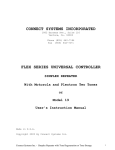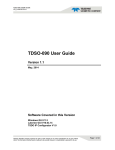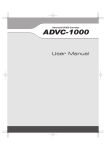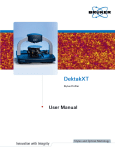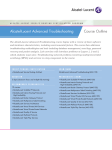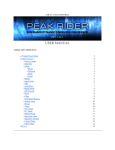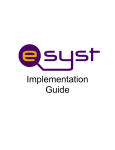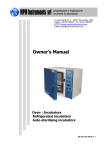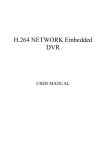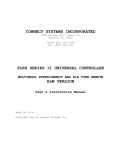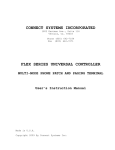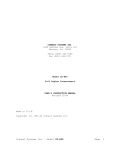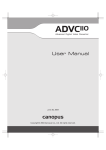Download Multiprotocol Commun..
Transcript
CONNECT SYSTEMS INCORPORATED 1802 Eastman Ave., Suite 116 Ventura, Ca. 93003 Phone (805) 642-7184 Fax (805) 642-7271 FLEX SERIES UNIVERSAL CONTROLLER MULTIPROTOCOL COMMUNICATION DECODER User’s Instruction Manual Made in U.S.A. Copyright 2003 By Connect Systems Inc. CONNECT SYSTEMS INCORPORATED 1802 Eastman Ave., Suite 116 Ventura, Ca. 93003 Phone (805) 642-7184 Fax (805) 642-7271 FLEX SERIES UNIVERSAL CONTROLLER MULTIPROTOCOL COMMUNICATION DECODER User’s Instruction Manual SPECIAL VERSION Made in U.S.A. Copyright 2003 By Connect Systems Inc. TABLE OF CONTENTS General Description Connections Adjustments Jumper Straps Multiprotocol Communication Decoder Operation Warranty FCC Notice to users 3 4 6 8 9 11 12 ----------------------------------------------------------GENERAL DESCRIPTION The FLEX Series Universal Controller MULTIPROTOCOL COMMUNICATION DECODER by Connect Systems Inc. is an economical decoder capable of decoding simultaneously DCS, CTCSS, LTR, and DTMF. Some of the more advanced features not available in any other decoder today is the ability to decode all four protocols at the same time, and the absence of the need to select the polarity on either the DCS or LTR formats. Powerful built in standard features make the FLEX Series Universal Controller Multiprotocol Communication Decoder the best deal going Communication Decoders today! This version differs from the standard version in that the DTMF when detected is outputted to the serial port immediately instead of waiting for a timeout or eight characters to accumulate. THE CONNECTIONS RX AUDIO For the products detecting CTCSS, DCS, or LTR, or products that use the internal squelch, the RX AUDIO must be connected to the discriminator of the radio. For all other products the RX AUDIO can be connected to the discriminator, high side of the volume control, or the speaker. TX AUDIO For products that generate CTCSS, DCS, or LTR, the TX AUDIO must be connected directly to the modulator of the transmitter. For LTR and DCS, the modulator must be true FM. For CTCSS the modulator can be phase modulated or FM modulated. For all other applications, connections to the high side of the microphone is acceptable. It should be noted that in most communication controllers there is a separate line for voice audio and a separate line for the CTCSS, DCS, or LTR signals. This is because to combine the two the controller has to have a limiter on the voice line to prevent over modulation and other undesirable side effects. The Flex Series Controllers has a built in limiter thereby not requiring separate lines. PTT The PTT normally hooks to the PTT of the transmitter. If you are using a Hand Held with the PTT sharing a common connection with the transmit audio, then attach a resistor with a value between 2.4K and 4.7K from the PTT to the TX Audio and attach the TX audio line to the center conductor of the microphone cable. In most product that use the PTT, the AUX relay can also be used as a PTT connection. This has the advantage of allowing positive keying or other situations where the normal open collector PTT does not work. COS Connect to a point that has a good voltage swing when the squelch is opened/closed. The best point to connect is to the collector of the transistor that controls the busy light (if the receiver has one). Otherwise you may connect to the squelch control voltage. The minimum voltage for the COS is about .4 volts and the Maximum voltage is the supply voltage. Some radios have that point coming out the back of the radio. It sometimes goes under the name of squelch detect, sq det, or COR. In some case a pull up or pull down resistor is necessary. The polarity and other parameters associated with the COS is contained within the programming parameters described later. It should be noted that in most cases, the COS can be replaced with the internal squelch. SENSE This point is used as an auxiliary input for specialized purposes in certain products. As an example, this input may be used to detect the presence of a CTCSS/DCS signal in an LTR system. The minimum voltage for the sense input is about .4 volts and the Maximum voltage is the supply voltage. The polarity and other parameters associated with the SENSE is contained within the programming parameters if used. AUX RELAY These two points connects to the center contact and normally open contact of the relay. The use if any depends upon the product. +12 VDC Connect to a source of 12 volts to 15 volts DC. The Flex Series Controllers are reverse polarity protected, so a polarity mistake will not damage the product. Connect the return lead to ground. The two grounds in the system are connected to each other. ADJUSTMENTS P1 HYB BAL The Hybrid Balance control is used to null out the mobile return audio in full duplex mode. The alignment must take place on one of the phone lines the Flex Series controller will be serving. (This alignment can not be done at the shop prior to delivery to the site.) Have a mobile place a call through the Flex Series Controller. The party answering the called phone should leave the phone off hook during the alignment procedure. Monitor the transmitter output with a service monitor or connect an oscilloscope to the "TX OUTPUT" terminal on the rear of the Flex Series Controller. Place all four Dip switches in the off position. Have the mobile simultaneously press digits 3 and 6 on his touch tone keypad. This will result in the transmission of a single 1477 Hz tone. Adjust the "HYB BAL" Potentiometer to produce the least audio output. Try all possible dip position combinations and null each time. The combination which gives the minimum output is the correct position to use. Changes made within the telephone company or rerouting of telephone lines could occasionally require re-adjustment of the hybrid. P2 Not Used P3 Tel Vox Used for detection of call progress tones and sensitivity to voice in Vox operated applications. Turning the pot clockwise increases its sensitivity. P4 Preamp The preamp control is used to match the audio level from your receiver to the Flex Series controller. To adjust, a signal containing 100 Hz CTCSS with about 600 Hz deviation should be applied to the receiver. Adjust the preamp control until a level of 3 volts peak to peak is observed at test point 6. If an oscilloscope is not available, read 1 volt RMS using a VOM. P5 RX VOX Used in VOX mode only. Sets RX audio triggering sensitivity. Should be fully clockwise in VOX simplex applications. Reduce setting when used through repeaters if land line cannot respond to mobile during hang time due to noise or tone on the repeater carrier. P6 AUDIO OUT Adjust the maximum level going to the transmitter. When turned fully clockwise, an output voltage of about five volts peak to peak is obtained. In most case the output level can also be set in the programming mode. P7 CONTRAST Sets the contrast of the LCD. Adjust to what is most pleasing to the individual. P8 SQUELCH Advance clockwise to a point just beyond where the front panel display "Rx" message disappears. Not all products will display the Rx message. JUMPER STRAP OPTIONS JP1 Line In Use Detector. When inserted, enables line in use detection. That allows the system to detect if another phone in parallel with the controller is off hook. Will only work with a phone system where the nominal on hook voltage is about 48 volts. JP2 Preamp Gain. With no jumper installed, gain is 100. With the jumper connected to the bottom two pins, the gain is about 10 with a .0047 uF capacitor giving 3 db cutoff of xxx Hz. With the jumper connect to the two pins, the gain is about 10 with a .047 uF capacitor giving a 3 db cutoff of xxx Hz. JP3 JP4 JP5 JP6 JP7 JP8 JP9 JP10 TO TO TO TO TO TO TO TO JP11 JP12 JP13 JP14 NOT NOT NOT NOT JP15 The terminating resistor when used for communication. Only use once per system. JP16 When inserted, allows the TX Audio output to be DC coupled. BE BE BE BE BE BE BE BE DETERMINED DETERMINED DETERMINED DETERMINED DETERMINED DETERMINED DETERMINED DETERMINED USED USED USED USED RS485 MULTIPROTOCOL COMMUNICATION DECODER OPERATION AUDIO TAKEOFF POINT The Multiprotocol Communication Decoder can be connected to a variety of places in the receiver depending upon what you wish to decode. To decode CTCSS, DCS, LTR, and DTMF, the audio in must be connected directly to the detector output (before de-emphasis). The De-Mod output on service monitors is suitable. In many receivers connecting to the Center Meter test point or to a TNC Packet output port may work satisfactorily. If you only wish to decode CTCSS and DTMF, a connection to the high side of the volume control may work. (CTCSS may not decode at this point depending upon how the receiver is configured). If you only care about decoding DTMF, a connection to the speaker leads will probably suffice (amateur receivers and scanners may even decode CTCSS at this point). If in doubt about where your detector output is, simply contact a technical representative at the company who produced your radio. Alternatively, send us a schematic diagram, and we will attempt to assist you, however bear in mind the manufacturer of your radio knows more specific details about your radio than we do. ADJUSTMENTS DTMF will not reliably decode unless the audio is properly deemphasized. Strap JP-2 must be connected from the center terminal to the top terminal if you have connected directly to the detector. If you have taken audio past the receiver's built-in deemphasis, JP-2 must be connected from the center terminal to the bottom terminal or no connection at all. While receiving a transmission containing a CTCSS, DCS, or LTR code (preferably about 600 Hz. deviation) adjust the GAIN potentiometer P4 for 3.0 volts peak-peak measured at TP-6 using an oscilloscope. If an oscilloscope is not available, turn P4 fully CCW and increase CW until LED D12 just begins to light. Be sure to make this adjustment only when a CTCSS, DCS, or LTR encoded signal is being received. Be sure a signal with CTCSS, DCS, or LTR is present, because the LED may also light on receiver noise when no signal is present resulting in an incorrect P4 setting. POLARITY STRAPS Because of the tremendous processing power of the system, it is possible to simultaneously decode DCS and LTR using both polarities. With DCS, both the normal and the inverse is decoded and displayed at the same time. With LTR, only the code that shows no errors is decoded. The older generation communication decoders such as the CD-2 and the LT-2 requires jumper straps to select the proper polarity. OPERATION The Multiprotocol Communication Decoder is fully automatic. When a tone or code is decoded it appears in the LCD display. The CTCSS, DCS, and LTR is displayed on the top line of the LCD display any DTMF codes are displayed on the bottom line of the LCD display. Because the LCD is alphanumeric, all codes can be displayed correctly on the display. If a DCS codes is received, then the display will show the first code followed by the inverse. An example of the display is "DCS 023 754". If a CTCSS code is shown, the code will be displayed along with a decimal point. An example of the display is "CTCSS 67.0" If a LTR code is displayed, the display will show the area bit (0 or 1), the repeater number (1 - 20), the ID code, and the GOTO code. An example of the display is "LTR 0 15 255 18" ABOUT the RS-232 SERIAL PORT The data presented on the LCD is also outputted to the serial port at 9,600 baud. The format is as follows: DCS NNN III<CR><LF> CTCSS NNN.N<CR><LF> or CTCSS NN.N<CR><LF> LTR A RR III GG<CR><LF> DTMF AAAAAAAA<CR><LF> where AAAAAAAA can be 1 to 8 characters LIMITED WARRANTY Connect Systems Inc. (CSI) hereby warrants our products to be free from defective workmanship for a period of one year and defective parts for a period of one year from date of sale to the initial end user. This warranty applies only to the original consumer/end user purchaser of each FLEX SERIES CONTROLLER. During the first year of warranty, CSI will repair any of its products at no charge providing the defective unit is shipped prepaid and service is performed by CSI. Conventional prevailing labor and shipping charges will apply following the end of the first year. CSI, at its sole discretion, will replace defective parts on an exchange basis for the first year of ownership by the original purchaser. All shipping cost are the responsibility of the customer. What is not covered by this limited warranty: This warranty shall not apply, if, in our judgment the defects are caused by misuse, lightning strikes, customer modification, water damage, negligent use, improper installation, overloads caused by external voltage fluctuations, use of unregulated power supply, damage caused by transit or handling or an abusive treatment not in accordance with ordinary product use or the product serial number has bee removed, altered, or defaced. Specific Exclusion: This warranty specifically excludes lightning protection devices (MOVs and phone line fuses) and transistors in the PTT (Push to Talk) circuitry. These components can only fail from external abuse. THIS WARRANTY IS IN LIEU OF ALL OTHER WARRANTIES, STATEMENTS OR REPRESENTATIONS, AND UNLESS STATED HEREIN, ALL SUCH WARRANTIES, STATEMENTS OR REPRESENTATIONS MADE BY ANY OTHER PERSON OR FIRM ARE VOID. ALL IMPLIED WARRATIES IN CONNECTION WITH THE SALE OF THIS EQUIPMENT, INCLUDING THE WARRANTY OF MERCHANTABILITY, SHALL BE OF THE SAME DURATION AS THE WARRANTY PERIOD STATED ABOVE. SOME STATES DO NOT ALLOW LIMITATIONS OF HOW LONG AN IMPLIED WARRANTY LAST, SO THE ABOVE LIMITATION MAY NOT APPLY TO YOU. IN THE EVENT OF PRODUCT FAILURE WHICH PROVES TO BE CAUSED BY A DEFECT IN WORKMANSHIP OF MATERIALS, YOUR SOLE REMEDY SHALL BE THE REPAIR OF THE DEFECT BY CSI OR ITS APPOINTED REPAIR STATION AS STATION AS STATED IN THIS WARRANTY, AND UNDER NO CIRCUMSTANCES SHALL CSI BE LIABLE FOR ANY LOSS OR DAMAGE, DIRECT, INCIDENTAL, OR CONSEQUENTIAL, ARISING OUT OF THE USE, OR INABILTY TO USE, THIS PRODUCT. SOME STATES DO NOT ALLOW THE EXCLUSION OR LIMITATION OF INCIDENTAL OR CONSEQUENTAL DAMAGES, SO THE ABOVE LIMITATION OR EXCLUSION MAY NOT APLLY TO YOU. If your new CSI product shall ever fail, contact Connect Systems Inc. Customer Service Dept. for repair and warranty information at (805) 642-7184 Note: Connect Systems Inc. reserves the right to render a modest service charge when returned units are found to be free of parts or workmanship defect(s) (i.e. operating to factory specification) within the first year of warranty. Such units will be returned freight collect to the sender, including the appropriate service charge. APPENDIX A FCC NOTICE TO USERS ------------------1. This device complies with part 15 of the FCC rules. Operation is subject to the following two conditions: (1) This device may not cause harmful interference, and (2) This device must accept any interference received, including interference which may cause undesirable operation. 2. This equipment generates and uses radio frequency energy and if not installed and used properly, i.e. in strict accordance with the service manual, may cause interference to radio or television reception. It has been tested and found to comply with the limits for a Class B computing device pursuant to Subpart J of Part 15 of FCC rules, which are designed to provide reasonable protection against such interference when operated in a residential installation. 3 If this equipment does cause interference to radio or television reception, which can be determined by turning the equipment off and on, the user is encouraged to try to correct the interference by one or more of the following measures: a. Reorient the receiving antenna. b. Relocate the equipment with respect to the receiver. c. Move the equipment away from the receiver. d. Plug the equipment into a different outlet so that equipment and receiver are on different branch circuits. e. Ensure that card mounting screws, attachment connector screws, and ground wires are tightly secured. f. If cables not offered by this company are used with this equipment, it is suggested that you use shielded, grounded cables with in line filters, if necessary. g. If necessary consult your dealer service representative for additional suggestions. 4 The manufacturer is not responsible for any radio or TV interference caused by unauthorized modifications to this equipment. It is the responsibility of the user to correct such interference.












